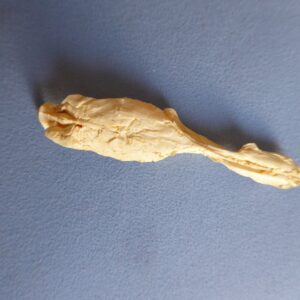All items sold on this website are polyurethane resin replicas, made in USA. No real or natural bone is available on this site.
Cornetfish Brain Replica
$32.00
Cornetfish are generally not considered dangerous to humans. They are shy and typically avoid contact with people. While they can be found in tropical and subtropical marine environments and have venomous spines, these are primarily used for defense when the fish feels threatened.
- Description
- Additional information
Description
Cornetfish Brain Replica measures 4.1 x 0.9 x 0.5 inches. Cornetfish Brain Replica is museum quality polyurethane resin. Made in USA. Exact species of Cornetfish replica is unknown. Our precise brain replica can be used as a teaching tool, museum brain exhibit, home décor brain, or office décor brain.
The Cornetfish or flutemouths are a small family, the Fistulariidae, of extremely elongated fish in the order Syngnathiformes. The family consists of a single genus, Fistularia, with four species, found worldwide in tropical and subtropical marine environments.
Ranging up to 2 m (6.6 ft) in length, Cornetfishes are as thin and elongated as many eels, but are distinguished by very long snouts, distinct dorsal and anal fins, and forked caudal fins whose center rays form a lengthy filament. The lateral line is well-developed and extends onto the caudal filament.
Cornetfish are found in tropical and temperate marine waters around the world, in the Atlantic, Pacific, and Indian oceans. They are often found in coastal waters over soft-bottomed areas like coral reefs, sand flats, and seagrass beds, where they feed on small fishes, crustaceans, and other invertebrates.
Cornetfish are of minor interest for fishing, and can be found in local markets within their range.
It is widespread in the tropical and subtropical waters of the Indo-Pacific as far north as Japan and east to the west coasts of the Americas, including Panama and Mexico’s Sea of Cortez and the Red Sea. In 2000, its presence was reported in the Mediterranean Sea off Israel. In the past twenty years, this species experienced a population explosion in the Levantine Sea and a rapid spread westward, reaching the westernmost sectors of the Mediterranean and as far north as the Gulf of Lions by 2007.
It has been recorded in all Mediterranean sub-basins and is now very common in the eastern part. F. commersonii is now considered an invasive species in the Mediterranean Sea because of its rapid development to reproductive stage and its detrimental effect on native fish populations. Scientists have determined that the fish in the Mediterranean are all descended from a small number of ancestors, possibly as a result of a single invasion event, and are not as genetically variable as their conspecifics in the Red Sea.
Cornetfish is usually a solitary predator, stalking and feeding on small fishes, crustaceans, and squid. Sometimes, they feed in small groups along the bottom on small, bottom-dwelling fish which their long snouts are very efficient at sucking up. These fish are adept at feeding on young fish that live in thickets of seagrass meadows (Posidonia oceanica), which can significantly reduce the ability of native fish populations to survive to reproductive adulthood. They can also hover or swim in small schools just below the surface. Reproduction is oviparous. The large eggs hatch and develop outside of the body. Larvae hatch at 6–7 mm (0.24–0.28 in).
Bacteria living in the mucus on the skin of the Bluespotted cornetfish may allow it to glide more easily through salt water.
Research on the parasites that live in bluespotted cornetfish reveals that parasites continue to thrive in its host even as it colonises non-native locations. This contradicts the prevailing theory, called enemy release hypothesis, that parasites would not be able to survive in hosts as they encounter new marine territory. The presence of introduced parasites affects not only Fistularia commersonii, but also other fish and marine animals in their native habitats.
The fish is of minor importance commercially, mostly being sold as fish meal but also fresh and preserved. It is also sold as an aquarium fish.
Cornetfish are known to be docile and will usually swim away when approached by humans. There are no reports or records of Cornetfish attacking humans.
Domain: Eukaryota
Kingdom: Animalia
Phylum: Chordata
Class: Actinopterygii
Order: Syngnathiformes
Suborder: Aulostomoidei
Superfamily: Aulostomoidea
Family: Fistulariidae
Blainville, 1818
Genus: Fistularia
Linnaeus, 1758
Type species: Fistularia tabacaria
Additional information
| Weight | 4.8 lbs |
|---|---|
| Dimensions | 4.1 × 0.9 × 0.5 in |




